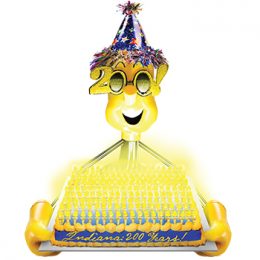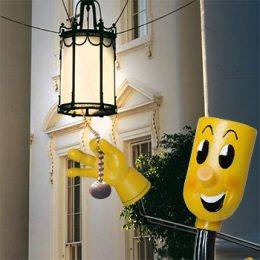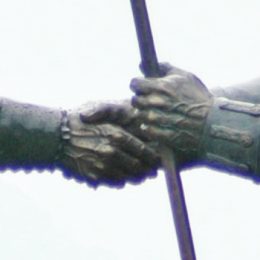Eighty years ago this month, Jesse Owens outran and out-jumped the world on his way to four gold medals in the August 1936 Summer Olympic Games in Berlin, Germany. But almost 40 years before Owens, another African-American athlete blazed a trail across North America and Europe. His mark was made on the bicycle.

Electric co-op mascot Willie Wiredhand says the Major Taylor Velodrome in Indianapolis is named in honor of the native Hoosier who became a world-renowned bicycle racing champion. This painted mural of Taylor is prominently featured inside the gate of the track. For more info about the velodrome, visit IndyCycloplex.com.
Marshall “Major” Taylor was such a dominating and acclaimed racing bicyclist at the turn of the 19th-to-20th century that he’s been described as the Michael Jordan or Tiger Woods of his time — a time when bicycle races drew giant crowds across both North America and Europe.
But as Taylor, who was African-American, rose to the top of his sport in his native Indianapolis, he had to overcome not only the competitors on the race track but also the tracks of racism. He faced open hostility from some white cyclists, cycling groups that sanctioned races and large segments of society, especially in the Midwest and South where he was kept from competing. Yet, like Jackie Robinson who broke the color barrier in Major League Baseball a half century later, Taylor, a devout Christian, carried himself with poise and dignity — and let his legs, heart and lungs speak for him and his race.
Between 1897 and 1900, Taylor was considered the fastest cyclist in the world. In 1898 and 1899, he established seven world records in various sprints. Some of his record times are still competitive today.
In August 1899, Taylor raced in the professional category at the Track Cycling World Championships in Montreal, winning the one-mile sprint event. In doing so, Taylor was the first black athlete from the United States, and just the second black athlete in any sport from anywhere, to hold a world title.
Taylor was born Nov. 26, 1878, in Indianapolis. During the Civil War, his father fought in an all-black Union regiment from Kentucky. Afterward, he purchased a small homestead on the outskirts of Indianapolis. From 1886-1891, Marshall Taylor was raised and educated in the home of a wealthy white Indianapolis family that employed his father as a coachman. The family gave him a bicycle.
Taylor quickly developed skills at trick riding and was hired by a bicycle retailer to perform stunts in front of his business to attract customers into his shop. Taylor wore a Civil War uniform while performing and was nicknamed “Major.”
Taylor’s talent was soon channeled toward racing, and, at age 13, the young biking whiz began winning sprint and long distance races in and around Indianapolis.
A local bicycle maker, former racer Louis “Birdie” Munger, took notice. He hired Taylor as an apprentice in his bicycle factory while nurturing Taylor’s racing career. By the fall of 1895, Munger decided to set up a new factory in Worcester, Massachusetts, and took Taylor with him. The move, in part, was to find a more tolerant atmosphere for his protégé.
In Worcester, Taylor turned professional and immediately began winning against the top riders from North America and Europe.
By 1898, he held seven world records. His record for the standing start one mile, 1:41, remained unbroken for 28 years. After being banned in previous years because of his race, Taylor was finally allowed to compete in the U.S. cycling championship series in 1900. He won the series to become the American sprint champion he had already proven he could be.
One of his biggest followers and supporters reportedly was President Theodore Roosevelt.
Taylor was extremely popular in Europe and spent the 1902 season racing across the continent. He won 40 of the 57 races he entered. The next two years, he also raced successfully in Australia and New Zealand.
Racing made Taylor one of the wealthiest African-Americans in the country, yet even in Worcester, racism showed up. When he bought a home in an upscale district, white neighbors were upset and offered to buy back the house for more than he had paid. Taylor refused. In the end, the neighborhood grew to accept its distinguished black resident and his family.
Taylor retired from racing in 1910 at the age of 32. He found little success in the business world, and debts, the stock market crash of 1929 and serious illness sapped his fortune. Impoverished and estranged from his wife, Taylor drove to Chicago in 1930 looking for a new start and hoping to sell his self-published autobiography. He died in 1932 in the charity ward of Cook County Hospital at age 53. He was buried in an unmarked pauper’s grave.
In 1948, a group of former pro cyclists, with financial help from Chicago’s Schwinn Bicycle Company, had his remains exhumed and placed in a more prominent part of the Mount Glenwood Cemetery on the southern outskirts of Chicago, just west of Munster, Indiana. His grave is marked with a bronze plaque.
Stay tuned each month as Willie presents more Indiana “Bicentennial Zingers.”




